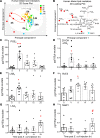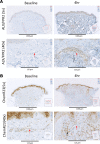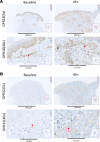Pro-resolving mediators promote resolution in a human skin model of UV-killed Escherichia coli-driven acute inflammation
- PMID: 29563331
- PMCID: PMC5926908
- DOI: 10.1172/jci.insight.94463
Pro-resolving mediators promote resolution in a human skin model of UV-killed Escherichia coli-driven acute inflammation
Abstract
While the treatment of inflammatory disorders is generally based on inhibiting factors that drive onset of inflammation, these therapies can compromise healing (NSAIDs) or dampen immunity against infections (biologics). In search of new antiinflammatories, efforts have focused on harnessing endogenous pathways that drive resolution of inflammation for therapeutic gain. Identification of specialized pro-resolving mediators (SPMs) (lipoxins, resolvins, protectins, maresins) as effector molecules of resolution has shown promise in this regard. However, their action on inflammatory resolution in humans is unknown. Here, we demonstrate using a model of UV-killed Escherichia coli-triggered skin inflammation that SPMs are biosynthesized at the local site at the start of resolution, coinciding with the expression of receptors that transduce their actions. These include receptors for lipoxin A4 (ALX/FPR2), resolvin E1 (ChemR23), resolvin D2 (GPR18), and resolvin D1 (GPR32) that were differentially expressed on the endothelium and infiltrating leukocytes. Administering SPMs into the inflamed site 4 hours after bacterial injection caused a reduction in PMN numbers over the ensuing 6 hours, the phase of active resolution in this model. These results indicate that in humans, the appearance of SPMs and their receptors is associated with the beginning of inflammatory resolution and that their therapeutic supplementation enhanced the resolution response.
Keywords: Eicosanoids; Inflammation.
Conflict of interest statement
Figures







Similar articles
-
Proresolving lipid mediators resolvin D1, resolvin D2, and maresin 1 are critical in modulating T cell responses.Sci Transl Med. 2016 Aug 24;8(353):353ra111. doi: 10.1126/scitranslmed.aaf7483. Sci Transl Med. 2016. PMID: 27559094 Free PMC article.
-
E-series resolvin metabolome, biosynthesis and critical role of stereochemistry of specialized pro-resolving mediators (SPMs) in inflammation-resolution: Preparing SPMs for long COVID-19, human clinical trials, and targeted precision nutrition.Semin Immunol. 2022 Jan;59:101597. doi: 10.1016/j.smim.2022.101597. Epub 2022 Feb 16. Semin Immunol. 2022. PMID: 35227568 Free PMC article. Review.
-
Resolvin D1 inhibits TGF-β1-induced epithelial mesenchymal transition of A549 lung cancer cells via lipoxin A4 receptor/formyl peptide receptor 2 and GPR32.Int J Biochem Cell Biol. 2013 Dec;45(12):2801-7. doi: 10.1016/j.biocel.2013.09.018. Epub 2013 Oct 10. Int J Biochem Cell Biol. 2013. PMID: 24120851
-
15-Epi-LXA4 and 17-epi-RvD1 restore TLR9-mediated impaired neutrophil phagocytosis and accelerate resolution of lung inflammation.Proc Natl Acad Sci U S A. 2020 Apr 7;117(14):7971-7980. doi: 10.1073/pnas.1920193117. Epub 2020 Mar 23. Proc Natl Acad Sci U S A. 2020. PMID: 32205444 Free PMC article.
-
Natural resolution of inflammation.Periodontol 2000. 2013 Oct;63(1):149-64. doi: 10.1111/prd.12034. Periodontol 2000. 2013. PMID: 23931059 Free PMC article. Review.
Cited by
-
Fa(c)t checking: How fatty acids shape metabolism and function of macrophages and dendritic cells.Eur J Immunol. 2021 Jul;51(7):1628-1640. doi: 10.1002/eji.202048944. Epub 2021 Apr 19. Eur J Immunol. 2021. PMID: 33788250 Free PMC article. Review.
-
The Resolution Approach to Cystic Fibrosis Inflammation.Front Pharmacol. 2020 Jul 29;11:1129. doi: 10.3389/fphar.2020.01129. eCollection 2020. Front Pharmacol. 2020. PMID: 32848748 Free PMC article. Review.
-
Current experimental methods to investigate the impact of specialized pro-resolving lipid mediators on Sjögren's syndrome.Front Immunol. 2023 Jan 12;13:1094278. doi: 10.3389/fimmu.2022.1094278. eCollection 2022. Front Immunol. 2023. PMID: 36713415 Free PMC article. Review.
-
Tissue factor targeting peptide enhances nanoparticle binding and delivery of a synthetic specialized pro-resolving lipid mediator to injured arteries.JVS Vasc Sci. 2023 Sep 26;4:100126. doi: 10.1016/j.jvssci.2023.100126. eCollection 2023. JVS Vasc Sci. 2023. PMID: 38045567 Free PMC article.
-
A New E-Series Resolvin: RvE4 Stereochemistry and Function in Efferocytosis of Inflammation-Resolution.Front Immunol. 2021 Feb 10;11:631319. doi: 10.3389/fimmu.2020.631319. eCollection 2020. Front Immunol. 2021. PMID: 33643307 Free PMC article.
References
-
- Segal AW, Peters TJ. Characterisation of the enzyme defect in chronic granulomatous disease. Lancet. 1976;1(7974):1363–1365. - PubMed
-
- Morgenstern DE, Gifford MA, Li LL, Doerschuk CM, Dinauer MC. Absence of respiratory burst in X-linked chronic granulomatous disease mice leads to abnormalities in both host defense and inflammatory response to Aspergillus fumigatus. J Exp Med. 1997;185(2):207–218. doi: 10.1084/jem.185.2.207. - DOI - PMC - PubMed
-
- Franceschi C, Campisi J. Chronic inflammation (inflammaging) and its potential contribution to age-associated diseases. J Gerontol A Biol Sci Med Sci. 2014;69 Suppl 1:S4–S9. - PubMed
-
- Vane JR, Botting RM. Anti-inflammatory drugs and their mechanism of action. Inflamm Res. 1998;47 Suppl 2:S78–S87. - PubMed
Publication types
MeSH terms
Substances
Grants and funding
LinkOut - more resources
Full Text Sources
Other Literature Sources

